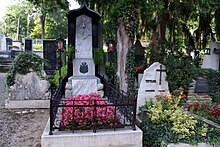Irene Abendroth

Irene Abendroth (born July 14, 1872 in Lemberg , Austria-Hungary , † September 1, 1932 in Weidling near Vienna ) was an Austrian singer with a coloratura soprano voice . Her lesser-known sister Mira Abendroth was also an opera singer .
Life
Irene Abendroth was born as the daughter of a family of drapers from Silesia in the capital of the Crown Land of Galicia . Very talented, she appeared in a concert for the first time at the age of 8. She received her training from Francesco Lamperti and Cleofonte Campanini in Milan and from Emma Mampe-Babnigg and Aurelia Jäger-Wilczek in Vienna. In 1888 she made her debut in Karlsbad and on February 15, 1889 at the Court Opera in Vienna as Amina in Bellini's La sonnambula . Engagements at the Riga Opera House (1890/91) and at the Kgl followed. Court and National Theater in Munich (1891–1894), where she sang Alice Ford on March 2, 1894 in the first performance of Verdi's Falstaff . From 1894–1899 she was back at the Vienna Court Opera, where she took part in the world premiere of Goldmark's opera Das Heimchen am Herd (March 21, 1896). After disagreements with the opera director Gustav Mahler , she left Vienna in 1899 and went to the Royal Court Theater in Dresden, where she was permanently engaged until 1909 and her career culminated in 1905 when she was awarded the title of Royal Saxon Chamber Singer . In Dresden she sang the title role in the German premiere of Puccini's Tosca in 1902 - also to the satisfaction of the composer, on October 30, 1903 she took part in the premiere of Bungert's Odysseus' Death in the role of Despoina. In addition, she made several guest appearances between 1905 and 1907 at the Berlin court opera Unter den Linden and had other invitations to the Kgl. Hofoper Stuttgart, the Frankfurt Opera (1907) and the Leipzig Opera as well as to the German Theater in Prague (1907).
After she left the stage, she performed more often in concerts as an oratorio and lieder singer, and from 1910 she devoted herself to her work as a singing teacher in Vienna. As a further distinction for her work, she was awarded the Austrian Golden Cross of Merit with the Crown .
Since 1900 she was married to the Austrian railway director Thomas Joseph Taller Edlem von Draga. In the inflation after the First World War she lost almost all of her fortune and lived in modest circumstances in Weidling. Her grave in the Weidlinger Friedhof is near that of the poet Nikolaus Lenau .
Abendroth is considered to be one of the most successful coloratura singers of her time with a virtuoso and at the same time dramatic voice. Her extensive repertoire included around 70 major roles.
Repertoire (selection)
|
|
Discography (selection)
- Johannes Brahms : Vergebliches Sändchen (1902): In: The First Opera Recordings 1895–1902 . CD, Symposium Records, 2003, SYM 1318, UPC Code: 760411318025
- Ambroise Thomas : Mignon (Mignon) Je suis Titania (Thomas) on Marston Records
- The Harold Wayne Collection Vol. 6, Symposium Records, 2002
- Yale Collection of Historical Sound Recordings, on Symposium Records, 2002
- Further references in: Lotz-Verlag: Discography of German Operatic and Lieder
literature
- Andrea Harrandt: Abendroth, Irene. In: Oesterreichisches Musiklexikon . Online edition, Vienna 2002 ff., ISBN 3-7001-3077-5 ; Print edition: Volume 1, Verlag der Österreichischen Akademie der Wissenschaften, Vienna 2002, ISBN 3-7001-3043-0 .
- Ch. Pollerus: Abendroth, Irene (1872–1932), singer. In: Austrian Biographical Lexicon 1815–1950 (ÖBL). Volume 1, Publishing House of the Austrian Academy of Sciences, Vienna 1957, p. 1 f. (Direct links on p. 1 , p. 2 ).
- Karl-Josef Kutsch , Leo Riemens : Large singer lexicon . Unchanged edition. KG Saur, Bern, 1993, first volume A – L, Sp. 3, ISBN 3-907820-70-3
- Thomas Thaller: Irene Abendroth. A fragment of her artistic career . With 56 photographs by the artist. E. Pierson, Dresden 1904
- Bruno Volger (Ed. And Red.): Saxony's scholars, artists and writers in words and pictures with an appendix: “Non-Saxony” . Gohlis Verlagbuchhandlung, Leipzig 1907/08
- Hans Schnoor : Dresden - 400 years of German music culture. For the anniversary of the Staatskapelle and the history of the d. Dresden Opera. (Ed. Erhard Bunkowsky). Dresdener Verlagsgesellschaft, Dresden 1948
Web links
- Irene Abendroth in the Bavarian Musicians' Lexicon Online (BMLO)
- Irene Abendroth in the Vienna History Wiki of the City of Vienna
- Irene Abendroth Picture in the Manskopf Collection of the Johann Wolfgang Goethe University in Frankfurt am Main
- Irene Abendroth Sound recording from the archive of the Austrian Media Library : ("I ask my uncomfortable heart" from Il barbiere di Siviglia )
Remarks
- ↑ Munich reception history of the Falstaff opera
- ↑ Your address in Dresden: Reichenbachstrasse 29
- ↑ Your address in Weidling: Löblichgasse 5
- ^ Lotz-Verlag
- ↑ a b c Berlin State Library
| personal data | |
|---|---|
| SURNAME | Abendroth, Irene |
| ALTERNATIVE NAMES | Taller Noble from Drago, Irene; Thaller Edle von Drago, Irene |
| BRIEF DESCRIPTION | Austrian singer with a coloratura soprano voice |
| DATE OF BIRTH | July 14, 1872 |
| PLACE OF BIRTH | Lviv , Austria-Hungary |
| DATE OF DEATH | September 1, 1932 |
| Place of death | Weidling near Vienna |
